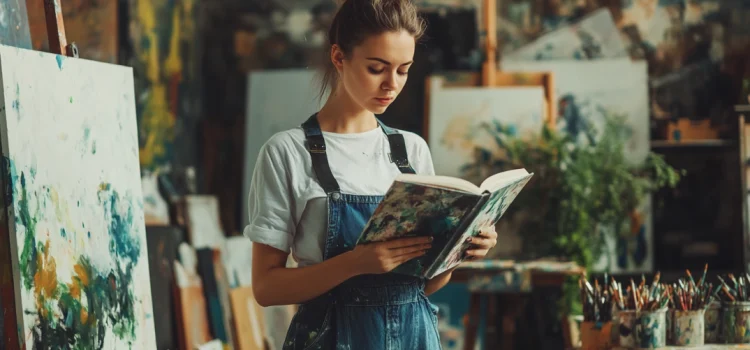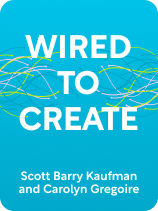

This article is an excerpt from the Shortform book guide to "Wired to Create" by Scott Barry Kaufman and Carolyn Gregoire. Shortform has the world's best summaries and analyses of books you should be reading.
Like this article? Sign up for a free trial here.
How is creativity defined? What are the most common creative characteristics? What can you do to boost your creativity?
According to Scott Barry Kaufman and Carolyn Gregoire in Wired to Create, creativity isn’t a characteristic itself, but rather the effect of a collection of different characteristics. By encompassing the 10 characteristics, you can maximize your creative potential.
Keep reading to learn what the 10 characteristics are in our overview of Wired to Create.
Overview of Wired to Create
Defining the creative person has been historically challenging because creative people are often walking contradictions—they’re introverted yet outgoing, focused yet easily distracted, and sensitive yet resilient. According to Scott Barry Kaufman and Carolyn Gregoire, this is because creativity isn’t a characteristic itself, but rather the effect of a collection of different characteristics.
Based on their research, Kaufman and Gregoire posit that creative people are ultimately defined by their deep connection to self, their curiosity and openness to both good and bad aspects of life, their unconventional and fantastical thinking, and their vigorous search for meaning. In Wired to Create, the authors argue that creatives possess 10 specific characteristics that encompass these traits and contribute to their heightened creativity. As a result, embracing these characteristics despite their contradictory nature will help you develop a deeper connection to yourself that will enhance your creativity and ability to express yourself.
Kaufman is a cognitive psychologist, speaker, and author who focuses on intelligence, creativity, and human potential. He’s the author of numerous books including Transcend and Ungifted, the founder of the Center for Human Potential and Self-Actualization Coaching, and the host of The Psychology Podcast. Gregoire is a writer and collaborative author who focuses on creativity, health, psychology, and spirituality. She has cowritten numerous books including Thrive and The Sleep Revolution by Arianna Huffington. She’s also the creator of Creative Types, a Webby Award-winning personality test.
In this article, we’ll explore Kaufman and Gregoire’s 10 creativity characteristics, explaining how they manifest and why they enhance creativity. In our commentary, we’ll supplement the authors’ discussion with information from other experts and books on creativity and well-being like The Artist’s Way by Julia Cameron and That Little Voice In Your Head by Mo Gawdat.
Characteristic 1: Childlike Imagination
According to the authors, the first characteristic that creative people share is a childlike imagination. This characteristic is defined by the desire to create something fun or enjoyable out of something typically mundane. In childhood, this characteristic is present whenever we play pretend—we pretend that a fallen tree in the forest is a kitchen counter and that pinecones and leaves are ingredients for a stew. Or, we make up a fantasy world and act out character roles with our friends.
In adulthood, this characteristic manifests when we explore our thoughts and experiences and use them to create something. The act of creation is “play” for the adult creative. For example, theorizing about something and sharing your theory is creative play—you use your childlike imagination to take something mundane and create something new. Channeling your experiences into a book, play, painting, and so on is also a form of creative play—you’re transforming your real life encounters into something new that you can share with others.
Kaufman and Gregoire add that childhood play often lays the groundwork for adult creatives’ ability to engage with their childlike imagination. Studies show that for children, imaginative play boosts cognitive development and is a way to explore, engage with, and find meaning in their environment.
These childhood experiences often transfer into adulthood, making the adult creative more curious and explorative than someone who lacked imaginative play in childhood. Further, childhood experiences with inventive play often provide a framework for the adult’s creative work—for example, turning your experiences playing in an “enchanted forest” as a child into a collection of paintings as an adult.
Characteristic 2: Passion
The second characteristic that Kaufman and Gregoire say creatives share is passion. Passion is defined by a lasting, intense inner drive to achieve a particular thing. For creatives, passion is often a primary source of meaning in life and one of the driving factors behind their will to live.
According to the authors, there are two phases of passion. First is the crystallizing experience—this is when the creative first encounters their area of passion and has the revelation that this is something they’re compelled to pursue. Second is the refining experience where the creative uncovers their specific niche within their area of passion.
For example, you may have a crystallizing experience in childhood where you realize you love history. After exploring that interest, you later have a refining experience while watching a documentary on Egyptology—you realize you want to be an Egyptologist uncovering lost artifacts and piecing together the politics, culture, and society of ancient Egypt.
The authors explain that passion is closely linked to creativity for two main reasons.
First, passion provides us with an intense internal drive to work toward our goals, which helps us overcome obstacles and persevere in the face of suffering. This drive is crucial because obstacles and suffering are natural parts of the creative process—you must be able to overcome them to achieve your creative goals.
Second, the intense drive produced by passion allows creatives to more easily enter a state of flow—a high-level focus state where you become consumed in your work and the outside world fades away. Flow is key to creativity because in this state, the networks in our brain that control imagination and our ability to identify relevant information are highly active. This makes us more likely to find significance in information we would otherwise pass over, and to make unique connections between these bits of information—making new connections is the foundation of creativity.
Characteristic 3: Daydreaming
The third characteristic that Kaufman and Gregoire say creative people share is the habit of daydreaming. Daydreaming is when you explore your thoughts and let your mind wander as opposed to consciously directing your attention to one particular thing. Daydreaming may take the form of fantasizing about certain scenarios, exploring memories, imagining the future, contemplating certain experiences or emotions, and so on.
The authors explain that daydreaming is critical for creativity because it gives our task-focused mind (the one used in flow) a break and allows us to process the experiences and information we’ve gathered. The enhanced understanding about our lives and ourselves that we gain during this processing state allows us to come up with unique ideas and insights that we share through creative expression.
Further, say the authors, thinking about past experiences may help you uncover new meanings and insights about humanity or life. They explain that when we develop these insights, we often feel the need to share them with others. Creative expression, like art or writing for example, is how we do so. In other words, developing new insights ignites our creative drive.
Characteristic 4: Mindfulness
The fourth characteristic the authors say creatives share is mindfulness. The authors define mindfulness as the ability to pay attention to the finer details of life in both your outer and inner world—for example, noticing the bumps and ridges on a tree’s bark or the way you feel when you watch a certain part of a movie.
The authors explain that the combination of daydreaming and mindfulness seems contradictory but is the perfect formula for creativity. Daydreaming allows your mind to think about and notice many different things, and mindfulness allows you to hone your focus and elicit meaning from things you find particularly impactful. The combination of these two characteristics is the formula for finding meaning in life and developing insights into the human experience—the two main drives that encourage creative people to create.
Further, the authors explain that practicing mindfulness trains us to control and direct our attention—focusing on specific elements teaches us to quiet our inner monologue and control thoughts that might disrupt our focus. This facilitates creativity because it allows us to more easily enter and maintain a state of flow.
Characteristic 5: Solitude
The fifth characteristic that the authors say artists share is the desire for solitude. The lonely artist trope has existed for centuries, and the authors explain that there’s a good reason for this: Creativity stems from an intimate understanding of one’s self and humanity, and these discoveries are the product of deep reflection, which requires solitude.
In solitude, people are granted the time and peace needed to fully explore their thoughts, emotions, and experiences, and to contemplate things they wouldn’t normally think about. This deep contemplation is the catalyst for meaningful epiphanies about yourself and the world—the tissue of creative work. Distractions in the outside world often prevent this intense inner focus, which is why solitude is crucial for creativity.
The authors say that this phenomenon can be explained by the networks of our brain that are active during solitude versus when we’re in the outside world. In the outside world, the high-focus network of our brain suppresses our imagination, directing our attention to our environment rather than our creative thoughts. On the other hand, in solitude, our high-focus network works with our imagination, which heightens our ability to develop creative thoughts and insights.
Characteristic 6: Intuition
According to the authors, the sixth characteristic creatives share is strong intuition. Intuition is an inner feeling you have that urges you to do something or change your frame of mind. For example, intuition can be an intense emotion, the urge to explore something, a sense of knowing something you can’t prove, and so on. The authors explain that intuition, or gut instinct, is often a catalyst for creative insights. Many creative people believe that their intuition, and consequently their creative insights, come from some higher power.
While the authors acknowledge the possibility of intuition coming from a higher power, they also explore the more scientific perspective that intuition is a product of the automatic processing system of our mind. This perspective also explains why creativity is linked to intuition.
Whereas the deliberate processing system of our mind is more controlled and analytical when generating ideas, the authors explain that the automatic processing system is spontaneous and often relies on information that we’ve implicitly and subconsciously learned through experiences. When using the automatic system of idea generation, our mind makes unique connections between past experiences and current stimuli that come to us in a sudden burst of “inspiration.” The more unique and unconventional these connections are, the more creative our ideas are. This is why following your intuition—or using your automatic processing system to generate ideas—often produces creative insights.
For example, imagine you’re an avid fiction reader—you’ve read a variety of genres with different themes and plots. Your subconscious mind has absorbed all the different story lines, plot developments, and literary strategies you’ve read. When writing your own book, you may experience intuition telling you to make certain unique decisions pertaining to your plot or characters. This internal guidance may seem mysterious, but it’s likely a result of your automatic processing system drawing connections between all the different books you’ve read and combining different writing strategies to help you come up with something new.
Characteristic 7: Experiential Curiosity
The seventh characteristic that the authors say creatives share is experiential curiosity—the desire to learn about yourself and the world through new experiences. Experiential curiosity is one of the biggest driving factors of creativity because new experiences are often the foundations of creative work—creativity arises when we break our typical patterns. Further, people who seek new experiences and knowledge tend to be more driven to find and make meaning out of the world around them, and this meaning is the material of creative expression.
According to the authors, research has uncovered three common forms of experiential curiosity. The first form is the drive to find truth, solve problems, and explore ideas. The second form is the drive to understand human emotion, which is accompanied by the tendency to rely on intuition and emotion in decision-making. The third form is the drive to explore art and elements of unreality, and to have emotional experiences in doing so.
The authors add that creative people are curious because they have high levels of dopamine. Aside from being the neurotransmitter that gives you feelings of pleasure and motivation, dopamine also encourages plasticity, which controls our desire to explore and try new things, whether it be experiences or ways of thinking.
Characteristic 8: Sensitivity
The eighth characteristic that the authors say creatives share is sensitivity. Sensitive people experience intense emotions and often are more in tune with and impacted by their surroundings. For example, a sensitive person may be more likely to notice the subtle nuanced brush strokes in a painting, or they may be better equipped to pick up on others’ emotions. They’re also more likely to be strongly emotionally impacted by their experiences—both positively and negatively.
The authors explain that sensitivity is linked to creativity for a few reasons. First, sensitive people have more intense emotional experiences, and emotions are often the inspiration for creative expression. Further, sensitive people tend to pick up on things that most people don’t. This provides them with a deeper understanding of the world, which sparks creative insights.
Characteristic 9: Creative Resilience
The ninth characteristic that the authors say creative people share is creative resilience—feeling their emotions intensely, using them to develop a deeper understanding of themselves and the world, and then sharing the insights they’ve gained through creative expression.
The authors explain that many artists use creative expression as a way of releasing pain and suffering. Turning pain into art, for example, helps creatives cope because it makes their suffering meaningful. Sharing their experiences is also cathartic because it allows creatives to connect with others—it makes them feel less alone in their experiences and produces the same effect for those viewing their art.
This characteristic is closely linked to characteristic 8: sensitivity. Because creatives are so sensitive, they’re more likely to be heavily impacted by traumatic experiences and carry suffering in the form of mental and emotional disorders. However, being creatively resilient allows creatives, distinctly, to flourish in the face of this adversity.
The authors add that this phenomenon—turning suffering into meaning and growth—has been scientifically observed and labeled “post-traumatic growth.” One study found that more than half of the people who experienced trauma in their sample group reported significant mental or emotional growth.
However, researchers say that for growth to occur after trauma, the traumatic experience must 1) deeply challenge the person’s previously held beliefs about the world and themselves, and 2) cause them to rewrite their perspectives and develop new insights. As we’ve discussed, these insights are often the fodder for creative expression.
Characteristic 10: Unconventional Thinking
The final characteristic that the authors say creative people share is unconventional thinking. Creatives tend to think beyond standard rules and expectations that traditionally limit people. They break barriers and set new trends by refusing to conform.
The disruption that creative people cause often paves the way for massive change—for example, an inventor often needs to challenge what we know about science to create new commodities that make our lives easier or more efficient. However, the authors note that because creative work breaks norms and traditions, it often goes unrecognized initially.
This is because people typically praise conformity and resist things that are different. It’s our evolutionary drive to be risk averse—risks present danger, and newness is a risk. As a result, people need time to get used to a new concept before they can consider its merit.
For example, most people rejected the idea of automobiles when they were first invented—using a machine rather than a horse to get around seemed dangerous and scary. However, it’s hard to imagine how our current society would function without automobiles. Similarly, people may resist a new form of art if it goes against what’s traditionally considered “beautiful.” However, concepts of beauty change over time—the more we’re exposed to something, the more we’ll begin to accept and even prefer it.
Exercise: Pursue New Experiences
According to the authors, one characteristic that sets creatives apart from the average person and contributes to their heightened creativity is experiential curiosity—their desire to learn about themselves and the world through new experiences. In this exercise, we’ll identify your primary form of curiosity and brainstorm experiences to help you explore it.
- The authors argue that experiential curiosity comes in three forms: 1) the drive to find truth, solve problems, and explore ideas, 2) the drive to understand human emotion, and 3) the drive to explore art and elements of unreality. Which of these forms do you feel most driven to explore?
- What is one element of your primary form of experiential curiosity that you want to explore? For example, if you’re most driven to understand human emotion, you may feel compelled to specifically understand euphoria—what causes it, what it feels like, and what it means.
- Now, list some ways you can gain a deeper understanding of that element through experience. For example, you can do things that make you feel euphoric like hiking or riding roller coasters. Alternatively, you can attend events that make others feel euphoric—like a concert for example—and observe their reactions.

———End of Preview———
Like what you just read? Read the rest of the world's best book summary and analysis of Scott Barry Kaufman and Carolyn Gregoire's "Wired to Create" at Shortform.
Here's what you'll find in our full Wired to Create summary:
- What creativity truly means—and why it’s hard to define
- The 10 characteristics of creative people
- How to maximize your creative potential







What is the first characteristic that creative people share, according to the authors?